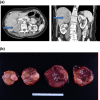Adrenal Cortical Carcinoma Associated With Lynch Syndrome: A Case Report and Review of Literature
- PMID: 30963136
- PMCID: PMC6446885
- DOI: 10.1210/js.2019-00050
Adrenal Cortical Carcinoma Associated With Lynch Syndrome: A Case Report and Review of Literature
Abstract
Objective: Adrenocortical carcinoma (ACC) is a rare malignancy with poor prognosis. ACC was reported in 3.2% patients with Lynch syndrome (LS), however no particular case-detection strategies have been recommended.
Participants: We report a case of a 65-year-old woman who was incidentally discovered with a large adrenal mass during work-up of postmenopausal uterine bleeding. She was recently diagnosed with MSH6 germline mutation after her sister presented with uterine carcinoma in the setting of LS.
Results: Whereas the patient was asymptomatic for overt hormonal excess, biochemical work-up confirmed glucocorticoid autonomy and androgen and estrogen excess. Urine steroid profiling was suggestive of ACC. Adrenalectomy confirmed an oncocytic ACC with focal extracapsular extension into the periadrenal adipose tissue with a Ki-67 of 15% and a peak mitotic count of 40/50 high-power fields.
Conclusion: ACC can be the only manifestation of LS. A best case-detection approach for ACC in the asymptomatic patient with LS is unclear, however urine steroid profiling could be considered.
Keywords: Lynch syndrome; adrenocortical carcinoma; adrenocorticotropic hormone; diagnosis; steroid profiling.
Figures
Similar articles
-
Characteristics of Adrenocortical Carcinoma Associated With Lynch Syndrome.J Clin Endocrinol Metab. 2021 Jan 23;106(2):318-325. doi: 10.1210/clinem/dgaa833. J Clin Endocrinol Metab. 2021. PMID: 33185660 Review.
-
Estrogen-secreting adrenocortical tumor in a postmenopausal woman: a challenging diagnosis.Endocrinol Diabetes Metab Case Rep. 2021 Mar 15;2021:20-0214. doi: 10.1530/EDM-20-0214. Online ahead of print. Endocrinol Diabetes Metab Case Rep. 2021. PMID: 33845455 Free PMC article.
-
Adrenocortical carcinoma masquerading as pheochromocytoma: a histopathologic dilemma.Endocrinol Diabetes Metab Case Rep. 2020 Jan 8;2020:19-0147. doi: 10.1530/EDM-19-0147. Online ahead of print. Endocrinol Diabetes Metab Case Rep. 2020. PMID: 31917677 Free PMC article.
-
Small adrenal incidentaloma becoming an aggressive adrenocortical carcinoma in a patient carrying a germline APC variant.Endocrine. 2020 Apr;68(1):203-209. doi: 10.1007/s12020-020-02209-4. Epub 2020 Feb 22. Endocrine. 2020. PMID: 32088909
-
Giant nonfunctioning adrenal tumors: two case reports and review of the literature.J Med Case Rep. 2018 Nov 10;12(1):335. doi: 10.1186/s13256-018-1876-8. J Med Case Rep. 2018. PMID: 30413177 Free PMC article. Review.
Cited by
-
Tumor Microenvironment in Adrenocortical Carcinoma: Barrier to Immunotherapy Success?Cancers (Basel). 2021 Apr 9;13(8):1798. doi: 10.3390/cancers13081798. Cancers (Basel). 2021. PMID: 33918733 Free PMC article. Review.
-
Pathogenic Insights into DNA Mismatch Repair (MMR) Genes-Proteins and Microsatellite Instability: Focus on Adrenocortical Carcinoma and Beyond.Diagnostics (Basel). 2023 May 26;13(11):1867. doi: 10.3390/diagnostics13111867. Diagnostics (Basel). 2023. PMID: 37296718 Free PMC article. Review.
-
Adrenocortical Carcinoma: Updates of Clinical and Pathological Features after Renewed World Health Organisation Classification and Pathology Staging.Biomedicines. 2021 Feb 10;9(2):175. doi: 10.3390/biomedicines9020175. Biomedicines. 2021. PMID: 33578929 Free PMC article. Review.
-
Key MicroRNA's and Their Targetome in Adrenocortical Cancer.Cancers (Basel). 2020 Aug 6;12(8):2198. doi: 10.3390/cancers12082198. Cancers (Basel). 2020. PMID: 32781574 Free PMC article. Review.
-
Molecular genotyping of adrenocortical carcinoma: a systematic analysis of published literature 2019-2021.Curr Opin Oncol. 2022 Jan 1;34(1):19-28. doi: 10.1097/CCO.0000000000000799. Curr Opin Oncol. 2022. PMID: 34669649 Free PMC article. Review.
References
-
- Fassnacht M, Arlt W, Bancos I, Dralle H, Newell-Price J, Sahdev A, Tabarin A, Terzolo M, Tsagarakis S, Dekkers OM. Management of adrenal incidentalomas: European Society of Endocrinology Clinical Practice Guideline in collaboration with the European Network for the Study of Adrenal Tumors. Eur J Endocrinol. 2016;175(2):G1–G34. - PubMed
-
- Iñiguez-Ariza NM, Kohlenberg JD, Delivanis DA, Hartman RP, Dean DS, Thomas MA, Shah MZ, Herndon J, McKenzie TJ, Arlt W, Young WF Jr, Bancos I. Clinical, biochemical, and radiological characteristics of a single-center retrospective cohort of 705 large adrenal tumors. Mayo Clin Proc Innov Qual Outcomes. 2017;2(1):30–39. - PMC - PubMed
-
- Lynch HT, de la Chapelle A. Hereditary colorectal cancer. N Engl J Med. 2003;348(10):919–932. - PubMed
-
- Karamurzin Y, Zeng Z, Stadler ZK, Zhang L, Ouansafi I, Al-Ahmadie HA, Sempoux C, Saltz LB, Soslow RA, O’Reilly EM, Paty PB, Coit DG, Shia J, Klimstra DS. Unusual DNA mismatch repair-deficient tumors in Lynch syndrome: a report of new cases and review of the literature. Hum Pathol. 2012;43(10):1677–1687. - PubMed
Publication types
LinkOut - more resources
Full Text Sources
Miscellaneous


